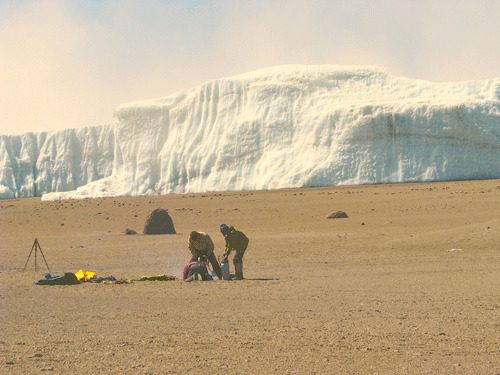

Permafrost near the equator; hummingbirds near the subarctic
Scientist and explorer Kenji Yoshikawa found permafrost on Mount Kilimanjaro, a volcano in Tanzania. During a September climb of Africa’s highest peak (19,331 feet), the University of Alaska Fairbanks researcher found permafrost not beneath the summit glaciers, but down the mountain a bit, at about 15,400 feet. There, outside the rocky border made by the terminal moraine of an ancient glacier, he found ground beneath the surface that has been frozen for many years. Permafrost is soil or any other ground material that has remained frozen through the heat of at least two summers. Yoshikawa thinks the ground’s exposure to cold air for many years formed the permafrost since glaciers never covered the area during the last extremely cold period.
Yoshikawa found no permafrost at the summit, where daytime ground temperatures reached 120 degrees Fahrenheit, and then plunged to minus 23 degrees at night. He thinks permafrost didn’t form at Kilimanjaro’s peak for two reasons—glaciers that were there during Earth’s last extreme cold period helped to insulate the soil from bitter cold air, and the heat of the volcano may have kept the ground at the summit too warm for permafrost to form there.
Yoshikawa said his favorite thing about the journey was the after-dinner relaxation time on the mountain, when climbers would build a campfire and the eight high school students from different African countries would ask Yoshikawa and biologist Kenji Narita questions about their scientific missions.
“I was very impressed with them,” he said of the students. “They don’t have textbooks, but they really wanted to learn. They were like a sponge.”
And, because both of the scientists on the trip had the same name, kids equated that name with doing research.
“They would say, ‘I want to grow up and be a Kenji,’” Yoshikawa said.
***
Anna’s hummingbirds, creatures that sometimes visit as far north as Girdwood, Homer, and Cordova, may be the fastest birds in the world if you adjust for body length, a scientist found while performing a study on the birds’ tail feathers.
Chris Clark, now at Yale University, was a graduate student at the University of California Berkeley studying the function of hummingbird tails. In watching male Anna’s hummingbirds perform a courtship dive in which they fly upward and then plunge up to 100 feet before pulling up, Clark determined through video analysis that the birds traveled 385 body lengths per second, or about 61 mph. A peregrine falcon dives at about 200 body lengths per second (about 160 mph). Clark also determined that the tails of Anna’s Hummingbirds produce a chirp when they’re diving; many people had assumed the sound was a vocalization.
Clark performed his research using either a caged female hummingbird or a stuffed female hummingbird to entice male birds at a park called the Albany Bulb, just west of Berkeley. He rode his bike down to the park on the weekend or after classes.
Alaskans in Southeast, or along the state’s south-central coast are much more likely to see Rufus hummingbirds than Anna’s, though a woman in Haines reported an Anna’s hummingbird at her sugar water feeder in late August 2009.
“The range (of Anna’s hummingbird) is extending north in recent decades,” wrote George West in the book, A Birder’s Guide to Alaska.






